Occupational environment monitoring at a chili sauce manufacturing factory
99,000 ₫
Note: The above price is calculated for one sample, and the price may fluctuate depending on the area of the environment to be monitored and market movements. For more accurate pricing support, please refer to the price list or contact our consulting staff directly.
Monitoring the environment of a chili sauce production factory is a session of collecting, analyzing, and evaluating workplace factors that may be harmful to workers’ health.
Table of Contents
Toggle1. Overview of Chili Sauce Production Factory
a. What is a chili sauce production factory?
Factory producing chili sauce is a production facility specialized in processing and manufacturing various types of chili sauce. Chili sauce is a food product made from chili peppers and other ingredients such as garlic, salt, sugar, and other spices. A chili sauce factory typically carries out processing and production stages to produce chili sauce products with consistent quality and flavor.

b. Production stages in a chili sauce factory
The production stages in a chili sauce factory may include:
- Ingredient preparation: Chili peppers and other ingredients such as garlic, salt, sugar, and spices are prepared and quality-checked.
- Washing and cleaning: Chili peppers are washed to remove dust, residue, and other impurities.
- Grinding: Chili peppers are ground into a smooth mixture. Grinding can be done using industrial grinders or manual grinders.
- Mixing ingredients: The ground chili mixture is combined with garlic, salt, sugar, and other spices. This mixing process ensures uniform blending and achieves the desired flavor.
- Cooking: The mixture is cooked to enhance the flavor and quality of the chili sauce. Cooking time and process may vary depending on the recipe and product requirements.
- Final cleaning and processing: After cooking, the chili sauce undergoes final cleaning and processing stages to achieve smoothness, uniformity, and product quality.
- Packaging: The finished chili sauce is packed into suitable containers such as bottles, jars, pouches, or boxes. Packaging may be automated or manual depending on production scale.
- Quality inspection: The chili sauce product is inspected to ensure it meets standards for flavor, taste, color, and food safety.

c. Types of machinery used in a chili sauce factory
In a chili sauce factory, several types of machinery are commonly used to carry out production stages. Some of the frequently used machines include:
- Chili washing machine: Used to clean chili peppers, removing dust, residue, and impurities before grinding.
- Chili grinder: Used to grind chili peppers into a smooth mixture. Can be industrial or manual grinders depending on production scale and requirements.
- Ingredient mixer: Used to combine ground chili with garlic, salt, sugar, and other spices, ensuring uniform mixing and desired flavor.
- Cooking machine: Used to cook the mixed ingredients to create chili sauce with a characteristic flavor. Typically equipped with temperature control and stirring functions to ensure even and efficient cooking.
- Packaging machine: Used to pack chili sauce into appropriate containers such as bottles, jars, pouches, or boxes. Functions include positioning, filling, sealing, and labeling.
- Quality inspection machine: Used to check critical parameters of chili sauce such as flavor, taste, color, and uniformity. Different technologies and sensors may be employed for quality assessment.

d. Occupational diseases that may occur for workers in chili sauce factories
Workers in chili sauce factories may encounter certain occupational diseases caused by environmental and work-related factors. Some common occupational diseases in the chili sauce industry include:
- Respiratory diseases: Working in an environment with chili dust and fumes may irritate and damage the respiratory tract, causing rhinitis, coughing, pneumonia, sinusitis, and other respiratory issues.
- Skin diseases: Prolonged contact with chili and other production ingredients can cause skin irritation, dermatitis, blisters, folliculitis, and allergic reactions.
- Eye problems: Exposure to chili and irritants can cause eye irritation, redness, itching, tearing, conjunctivitis, and other eye-related issues.
- Digestive disorders: Use of alcohol, preservatives, and other additives in chili sauce production may irritate the digestive tract, leading to gastritis, abdominal pain, indigestion, and other digestive problems.
- Spinal and musculoskeletal issues: Physically demanding tasks such as transporting raw materials, grinding, and cooking can strain the spine, causing back pain, arthritis, and musculoskeletal problems.
To ensure workers’ health and safety, chili sauce factories must comply with labor safety regulations and provide protective measures such as personal protective equipment and proper ventilation.

e. Popular types of chili sauce on the market
There are many popular types of chili sauce on the market, each with unique characteristics and flavors. Some common types include:
- Concentrated chili sauce: Highly thick with strong spiciness, used to enhance flavor and heat in dishes.
- Marinated chili sauce: A mixture of chili sauce with spices like garlic, ginger, onion, salt, and sugar, used for seasoning and cooking.
- Sweet and sour chili sauce: Mildly spicy, combined with sweet and sour flavors from vinegar, sugar, and other spices, used in dishes with a balanced sweet and sour taste.
- Traditional chili sauce: Made using traditional methods, with characteristic spiciness and bright red color, commonly used in traditional dishes and local specialties.
- Chili sauce with seeds: Contains chili seeds, giving a unique texture and flavor, often used for decoration and adding spiciness.
- Mild chili sauce: Lightly flavored with low spiciness, suitable for those who prefer mild taste.
2. Overview of Occupational Environment Monitoring Services
a. What is occupational environment monitoring at chili sauce factories?
Occupational environment monitoring (or workplace environment measurement) at chili sauce factories involves collecting, evaluating, and analyzing environmental factors at the workplace to implement timely measures, minimize environmental harm to workers’ health, and prevent occupational diseases. Occupational environment monitoring is mandatory for chili sauce factories.
It plays a crucial role in protecting and improving workers’ health because employees are the main resources of the company and directly generate profit. Workers exposed to risk factors exceeding permissible limits may suffer health issues and develop occupational diseases.
REGISTER FOR OCCUPATIONAL ENVIRONMENT MONITORING SERVICE
b. Nam Viet’s occupational environment monitoring program
Nam Viet’s occupational environment monitoring program is developed by monitoring engineers specializing in occupational safety and environmental protection. Aiming to ensure workers’ health and safety, the program uses modern measurement methods to monitor air, water, and microclimate, physical, and dust factors in the workplace. This program is essential for maintaining a safe working environment and protecting workers’ health.
Additionally, Nam Viet’s program contributes to researching and developing new solutions to improve workplace environmental quality. With a dedicated and professional team, Nam Viet’s exclusive monitoring program is a breakthrough in labor safety management and environmental protection in Vietnam.

c. Standardization in workplace measurement procedures
Standardization in Nam Viet’s workplace measurement procedures is crucial for ensuring measurement quality. To guarantee accuracy and reliability, the program follows standards recognized by the Ho Chi Minh City Department of Health. This ensures collected data are reliable for evaluating workplace conditions and making decisions to improve the environment and protect workers’ health.
These standardized procedures are carried out by qualified monitoring specialists with years of experience, providing managers and experts with trustworthy results for informed decisions to protect workers and the environment.
By applying standardized procedures, Nam Viet demonstrates its commitment to a safe working environment and actively contributes to improving labor safety management and environmental protection in Vietnam.
d. Report on occupational environment monitoring results at chili sauce factories
Monitoring results are compiled according to Form 04, Appendix III, issued with Decree 44/2016/NĐ-CP and prepared in two copies: one sent to the contracted workplace and one kept by the monitoring organization.
The retention period for monitoring results is unlimited according to legal regulations.

e. Frequency of occupational environment monitoring as required by law
According to Clause 2 of Article 18 of the Law on Occupational Safety and Hygiene 84/2015/QH13, employers must organize workplace environment monitoring for harmful factors at least once a year.
f. Deadline for submitting occupational environment monitoring reports as required by law
The deadline for report submission is before December 31 each year. Enterprises at production facilities are required to submit occupational environment monitoring reports to the Department of Health at the locality where the main office is located and where workers are employed.
When there are changes in technology, production processes, or during facility upgrades that may introduce new harmful factors affecting workers’ health, enterprises must update occupational hygiene records regarding harmful factors requiring monitoring.
g. Penalties for violations of occupational environment monitoring by employers
According to Article 27 of Decree 12/2022/NĐ-CP dated January 17, 2022, regulating administrative penalties in labor, social insurance, and Vietnamese workers working abroad under contract:
- Clause 2: Fines from 2,000,000 – 5,000,000 VND for employers who fail to publicly disclose monitoring results to workers at the monitored site and at locations where hazardous factors are assessed immediately after results are available.
- Clause 3: Fines from 20,000,000 – 40,000,000 VND for employers who do not conduct occupational environment monitoring to control harm to workers’ health as required by law.
- Clause 4: Fines from 40,000,000 – 60,000,000 VND for employers who collaborate with monitoring organizations to commit fraud in environmental monitoring activities but have not reached the level of criminal liability.
3. Environmental Factors Harmful to Workers in Chili Sauce Production Factories
Workers in chili sauce production factories may be exposed to several harmful environmental factors. Here are some potential environmental factors that could pose risks to workers in the chili sauce production industry:
- Spicy fumes and chili dust: The chili sauce production process often generates spicy fumes and chili dust in the workspace. Spicy fumes can irritate the eyes, throat, and respiratory system, while chili dust may cause skin irritation and eye contact issues.
- Chemicals: Chili sauce production processes may use chemicals such as acetic acid, sodium benzoate, flavorings, and other preservatives. Exposure to these substances can cause irritation to the skin, eyes, and respiratory system.
- Temperature and humidity: Some chili sauce factories may have high temperature and humidity levels in the workspace. This can cause discomfort, fatigue, and dehydration, especially in poorly ventilated environments.
- Noise: The chili sauce production process can generate noise from machinery, equipment, and work processes. Continuous and loud noise can affect hearing and cause stress to workers.
- Hygiene and cleanliness: In food production processes, maintaining hygiene and cleanliness is crucial. Exposure to an unclean working environment can lead to infections, poisoning, and other health issues.
REGISTER FOR WORKPLACE ENVIRONMENT MONITORING SERVICE
4. Measures to Improve the Working Environment in Chili Sauce Production Factories
To improve the working environment in chili sauce production factories and protect workers’ health, the following measures can be applied:
- Ventilation and exhaust systems: Ensure air circulation in the factory using ventilation and exhaust systems. This helps remove spicy fumes, chili dust, and toxic gases from the workspace, improving air quality and reducing respiratory issues.
- Use dust collection systems: Install efficient dust collection systems to capture chili dust and particles on equipment, machinery, and in the workspace. This reduces exposure to chili dust and the risk of skin and respiratory irritation.
- Provide personal protective equipment: Ensure workers are fully equipped and properly use personal protective equipment such as masks, safety goggles, gloves, and protective clothing. This protects them from direct contact with spicy fumes, chili dust, and other irritants.
- Training and education: Educating workers on occupational safety and hygiene is very important. Provide guidance on proper use of personal protective equipment, safe work procedures, and preventive measures for occupational diseases.
- Adjust temperature and humidity: Ensure a comfortable temperature and humidity in the workspace. This may require air conditioning, cooling fans, or other measures to regulate the working environment.
- Maintain hygiene and cleanliness: Ensure the workspace is clean and hygienic. Implement daily cleaning measures, including sweeping, wiping, and waste disposal. This helps prevent bacterial growth and reduce infection risks.
- Regular inspections: Conduct regular inspections of the working environment to ensure compliance with safety and hygiene standards. Inspect and maintain equipment, machinery, ventilation, and dust collection systems to ensure effective operation.
- Encourage rest and relaxation: Provide periodic rest and relaxation time for workers. This helps reduce stress and fatigue, improving overall health and mental well-being.
- Periodically conduct workplace environment monitoring in the factory, collect and analyze harmful factors to workers, and adjust to reduce risks to prevent occupational diseases.
5. Benefits of Periodic Monitoring in Chili Sauce Production Factories
An Toan Nam Viet provides businesses with great benefits when using workplace environment monitoring services according to Decree 44/2016/ND – CP on management and control of harmful factors in the working environment affecting employees.
- Businesses can proactively control harmful factors in workshops or factories.
- Receive advice and recommendations on measures to minimize harmful factors, improving the quality of the working environment.
- Indirectly protect human resources, the main factor in business development.
- Reduce the impact of occupational diseases on human health, thereby minimizing future treatment costs.
- Enhancing workers’ health leads to ensured and maintained product quality and output.
- Comply with occupational safety laws, avoiding legal risks.
- Create credibility and professionalism in all aspects, enhancing the brand reputation of businesses.
Nam Viet’s environmental monitoring service is a solution to minimize the impact of occupational diseases, contributing to a clean and high-quality working environment.

6. National Workplace Environment Monitoring Center
Workplace Environment Monitoring Center of Nam Viet is a professional unit specializing in monitoring and measuring workplace environmental quality across all provinces in Vietnam. With an experienced team of monitoring specialists, the center uses modern measuring equipment to ensure accuracy and reliability.
In addition to providing monitoring services, the center supports clients in planning, handling, and tracking workplace environment issues. With the motto “customer-centered,” the center prioritizes customer satisfaction, meets all customer needs, and commits to providing the best solutions for businesses.
REGISTER FOR WORKPLACE ENVIRONMENT MONITORING SERVICE
With investments in technology, equipment, and human resources, Nam Viet’s monitoring center has become one of the reputable units in workplace environment monitoring in Ho Chi Minh City with the following objectives:
- We always value our brand reputation and the quality of our services.
- We provide clients with the best and most suitable solutions possible.
- With a team of experienced Masters and Engineers, aiming to protect the environment and benefit businesses.
- With Nam Viet Environmental Monitoring, companies will receive professional service from experts in monitoring and enjoy the best cost incentives.
The workplace environment monitoring process at Nam Viet includes the following basic steps:
- Before conducting monitoring, our company ensures that all machinery and equipment are calibrated according to legal regulations.
- Strictly follow the committed monitoring procedures with the Department of Health.
- Report monitoring results honestly to employers.
- If monitoring results indicate unsafe conditions for workers, Nam Viet will support remediation solutions, and the enterprise shall:
- Implement measures to improve working conditions to minimize harmful factor impacts and prevent occupational diseases.
- Organize health check-ups to detect occupational and work-related diseases early for workers in unsafe positions.
- Provide compensation in kind to workers according to labor law regulations.

7. Workplace Environment Monitoring Price List
To help businesses conduct professional and effective workplace environment monitoring, Nam Viet provides clients with a price list of workplace environment monitoring services with quality and reasonable costs.
- Our price list provides detailed information about the costs of monitoring services we offer, including costs related to transportation, measurement, analysis, and reporting. Clients can be fully assured of the accuracy and reliability of the monitoring reports we provide.
- We commit to offering the most competitive and reasonable prices in the market, while always being ready to consult and answer all inquiries about monitoring services quickly and professionally.
- With Nam Viet’s monitoring price list, clients can easily select service packages that meet their needs. We guarantee maximum client satisfaction with professional service quality.
No comments yet

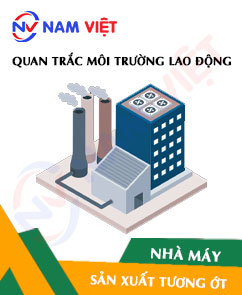
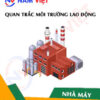
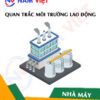

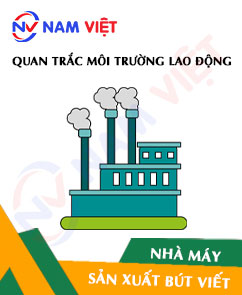
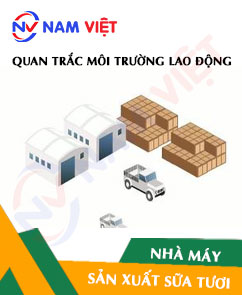


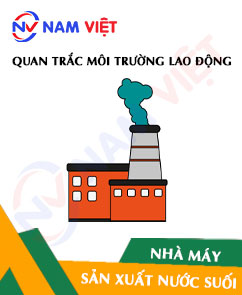

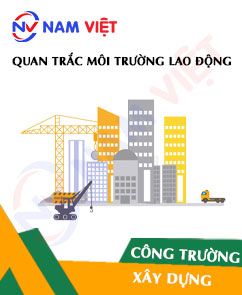
Review Occupational environment monitoring at a chili sauce manufacturing factory
There are no reviews yet.